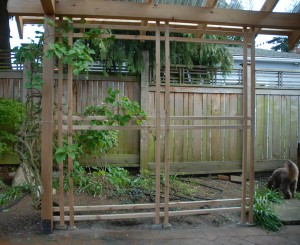The hardest part about completing the trellis was managing the slope of the patio. I began construction by laying out the notches for the joinery on 5/4 x 4 cedar boards, then began cutting the notches–36 in all. I took that effort in stages, beginning with the horizontal boards. I began by defining each edge of the notch with my dozuki, then making a couple of additional cuts across the notch, then popping the waste free with a chisel and paring the joint relatively even. Cedar is easy to work by hand, so this went fairly quickly, but I was ready to try the router when it came time to notch the vertical members.
I used a dado jig to line up a 3/4″ straight bit with the edge of the notch and let fly, then slid the jig over to complete a second pass to produce the 1.5″ wide notch. Although noisier and messier, the router produced neater cuts more quickly than my saw-and-chisel attempt. I then ripped each board into two 1.5″ wide pieces to bring the members to final dimension, planed out my saw marks, and rounded over the edges of the board. My roundover bit was too tall to fit in the 1/2″ notch, so I eased each edge of the notch with a file. This might seem a bit fussy, but the roundovers express the joint, creating a shadow line and helping to conceal irregularities in the joinery.
After dry fitting the assembly, I tackled that awkward slope in the patio. With my stone footings in place, I positioned each vertical member, flipping the bottom up to the porch beam to mark final length on the bottom end. Some quick work with the miter saw, and I was ready for final assembly. Since the bottoms of my notches weren’t all perfectly smooth and this is an exterior project, I chose to use a five-minute epoxy to glue the slats together. The short open time of the epoxy added some stress to assembly, but by mixing a small batch of epoxy and only gluing one row of joints together at a time I was able to keep things manageable. Springs clamps provided enough pressure to keep the slats together for the short time the epoxy cured.
Once I had the trellis where I wanted it, some stainless steel screws anchored it to the porch, and the climbing hydrangea has a home again.
More Information
I wrote about designing the trellis here.
While I can’t claim to have followed rigorously shoji-construction methods for this shoji-inspired trellis, I did find the following books useful background for the project.
Jay Van Arsdale offers a simplified approach to building in Shoji.
Toshio Odate offers a more traditional take on the subject in Making Shoji

